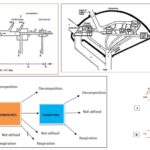IB Biology 48 Views 1 Answers
Sourav PanLv 9November 9, 2024
How is glycerate 3-phosphate reduced to triose phosphate using reduced NADP and ATP?
How is glycerate 3-phosphate reduced to triose phosphate using reduced NADP and ATP?
Please login to save the post
Please login to submit an answer.
Sourav PanLv 9May 15, 2025
In the Calvin cycle, glycerate 3-phosphate (3-PGA) is reduced to glyceraldehyde 3-phosphate (G3P), also known as triose phosphate, using ATP and reduced NADP++ (NADPH). This reduction process is essential for converting fixed carbon into a form that can be utilized to synthesize carbohydrates. Here’s a detailed overview of how this reduction occurs:
Steps in the Reduction of Glycerate 3-Phosphate
- Formation of 3-PGA:
- The Calvin cycle begins with the carboxylation of ribulose bisphosphate (RuBP) by the enzyme RuBisCO, producing two molecules of 3-PGA for each CO₂ molecule fixed.
- Phosphorylation of 3-PGA:
- In the first step of the reduction phase, each molecule of 3-PGA is phosphorylated by ATP. This reaction is catalyzed by the enzyme phosphoglycerate kinase, converting 3-PGA into 1,3-bisphosphoglycerate (1,3-BPG). The reaction can be summarized as:
3 PGA+ATP→1 3 BPG+ADP - Reduction of 1,3-BPG:
- The next step involves the reduction of 1,3-BPG to G3P. This reaction is catalyzed by the enzyme glyceraldehyde 3-phosphate dehydrogenase (GAPDH), which utilizes NADPH as a reducing agent. NADPH donates electrons and a proton to 1,3-BPG, resulting in the formation of G3P and oxidizing NADPH to NADP++. The reaction can be represented as:
1 3 BPG+NADPH+H+→G3P+NADP++Pi - Production of Glyceraldehyde 3-Phosphate (G3P):
- The final product of this reduction process is glyceraldehyde 3-phosphate (G3P), a three-carbon sugar phosphate that can be used to synthesize glucose and other carbohydrates or be recycled to regenerate RuBP in the Calvin cycle.
0
0 likes
- Share on Facebook
- Share on Twitter
- Share on LinkedIn
0 found this helpful out of 0 votes
Helpful: 0%
Helpful: 0%
Was this page helpful?




